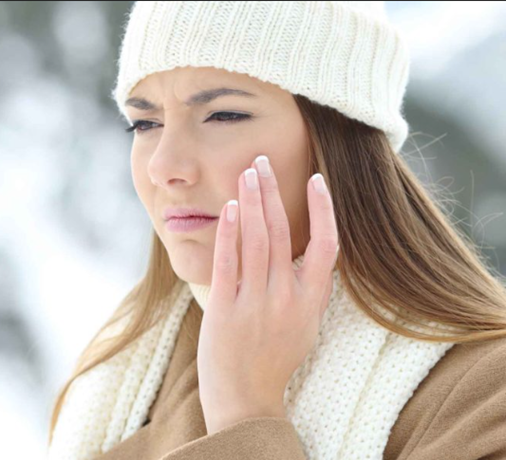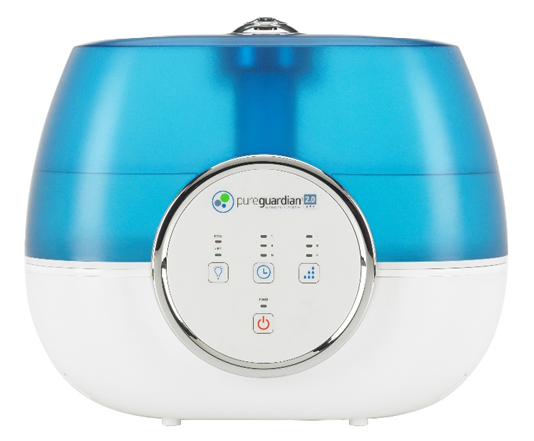Tips for Soothing Dry Winter Skin
Posted by Stephanie Phillips on Jan 22nd 2023
I love visiting my friends and family on the east coast but I am also reminded how spoiled we are living in southern California. I spent a little under 2 weeks and my skin already has noticeable signs of the cold, dry air. Not only is it overall dryer than usual but I also noticed some dry flaky patches that were not there 2 weeks ago…thus I dedicate this post to my east coast and mid-western friends in the midst of the winter season. While I cannot send you warmth, I figured the least I could do is give you some tips on how to prevent and combat dry winter skin.
What makes winter weather so harsh on your skin? Winter weather brings with it not only cool dry air, but also the need for the use of indoor heating and changes in eating and exercise. Due to these factors, it is common to have dryness, skin dehydration, irritation and even acne.
What is dry skin?
Dry skin, also known as xerosis or xeroderma, is due to water loss from the Epidermis or outer layer of skin. Dry skin is often temporary or seasonal — you might get it only in winter, for example — or you might need to treat it long term. Signs and symptoms of dry skin might vary based on your age, health status, skin tone, living environment and sun exposure. In this blog, I will focus on temporary dry skin caused cold, dry winter weather.
Dehydrated or Dry Skin?
Yes, there is a difference and depending on which you have, you will want to treat your skin accordingly. If you don’t know the difference, you could be treating your skin but not getting the desired results.
Dry skin is a skin type. It is caused when the skin lacks oil due to decreased oil production. Surprisingly it isn’t caused by lack of hydration or water retention.
Dehydrated skin is a skin condition that occurs when the skin lacks moisture or water. Dehydrated skin lacks water due to external factors like dry weather or using indoor heaters. Thus, it is more common in the winter due to the cold, dry air.
Keep in mind that is also possible to have both dry skin and dehydrated skin at the same time. To combat dehydration, but not overdo the oil, it is important to choose products that moisturize the skin but do not clog the oil glands.
Individuals with acne may find that acne worsens due to winter skin changes. This may be due to an imbalance of oil and water on the skin or lifestyle changes, such as eating and exercise. There is also some evidence that the decrease in temperature and exposure to ultraviolet light can alter the immune system function and result in acne.
Skin Irritation
Skin Irritation can occur during the winter months too. Dry wind can take moisture out of skin and cause dry, flaking rashes. The problem is further compounded by the use of indoor heating. This will change the humidity levels and dry your skin. This can leave you with dry, flaky patches or red, scaly areas and can make it harder to use products, as the skin may be more sensitive.

Symptoms of Dry Skin?
Depending on the severity of your dry skin, you can have any or all of the following symptoms.
- A feeling of skin tightness
- Skin that feels and looks rough
- Itchiness (pruritus)
- Slight to severe flaking skin
- Slight to severe scaling or peeling
- Cracked "dry riverbed" look to leg
- Fine lines or cracks
- Skin that ranges from reddish on white skin to grayish on brown and black skin
- Deep cracks that may bleed
- Acne
As you can imagine most of these symptoms are pretty uncomfortable and unsightly. Most importantly, it is your skin trying to tell you something and you know we are all about consciously listening to our bodies around here.
There are a few contributors to winter dry skin, but the three main culprits:
1.External Environment. Living in cold, windy conditions or low-humidity
climates.
2. Internal Environment. Central heating, wood-burning stoves, space heaters and fireplaces all reduce humidity in our home.

3. Lifestyle Changes. In cold months, we tend to go into a state of “hibernation” not quite like bears but our bodies do adjust to be able to handle the cold. We tend to eat a bit more as our body needs more energy to create heat, we go outside less, thus getting less sunshine and exercise.
How to Prevent and Repair Dry Winter Skin
Ok, now we know what causes it but what do we do about it? When cold weather approaches, it is important to be prepared. Making changes to your diet, skincare routine and home environment can make a huge impact on your skin's hydration levels during chilly months.
Water, Water, Water….
I could talk about water forever…it is so important that every cell, tissue and organ in the human body needs water to function properly. The body uses water to sweat to prevent overheating, avoid constipation, lubricate your joints, protect the spinal cord, protect sensitive tissues and remove waste from the body via urination and bowel movements.
It is important to make sure that you intake the correct amount of water daily to make sure that all of your bodily systems are sufficiently hydrated. The recommended amount of water for adult is around 2-3 liters per day. Your body may require more, depending on your daily activities, your weight and your environmental conditions. It never hurts to have an extra glass or two during the winter months.
Foods for Hydration
Since the skin is your body’s largest organ, it is important to fuel your body with foods that help your skin stay soft and smooth. Here are a few foods that you can add to your routine that will help keep your skin plump and moisturized from the inside out.
- Avocados: Avocados are superfoods for dry skin. They are rich in monounsaturated fatty acids that replenish the lost oils in your skin and make it supple again. They are also known to reduce inflammation on the skin and prevent the formation of dry flaky skin. Avocados are also rich in Vitamin E, known for its antioxidant properties that prevent the formation of wrinkles and sagging skin caused by dryness.
- Red, Yellow & Orange Fruits & Veggies: Pumpkins, Squash, Peppers, Oranges, Papaya are all rich in Beta-Carotene. A powerful antioxidant, Beta-Carotene can prevent oxidative stress on skin cells and encourage new cell growth. In addition, it is also known to protect your skin from UV radiation that is higher in winter.
- Chamomile: Herbal infusions like Chamomile tea are known to offer numerous benefits for dry and cracked skin. It offers quick relief from the itchy symptoms of this condition by calming down your nerves and making you feel relaxed. Chamomile tea has anti-inflammatory properties that can soothe irritated skin.
- Olives: Olives not only enhance the taste of your Italian food but also offer numerous benefits to our skin. These are rich in Oleic acid, which is a type of fatty acid that can protect your skin from excessive dryness and wrinkles. These fruits also contain Vitamin E, which is an essential nutrient for healthy, radiant skin. No wonder why it is hailed as the best food to cure dry skin! Apart from adding olives in your salads and Pastas, drizzle some olive oil in your foods.
- Green Leafy Veggies: Green leafy vegetables like Spinach, Kale etc. are the best foods to eat for dry skin in winters. These veggies are packed with nutrients like Vitamin C, Vitamin A and minerals like copper and iron which are essential for healthy skin. They are rich in essential fatty acids, which seal moisture to prevent skin from drying out. The antioxidants present in these foods fight free radicals that damage your skin cells. In addition, Green veggies are rich in dietary fiber that helps in flushing out toxins from the body to maintain a clean, flawless skin.
- Flax Seeds: Flaxseeds offer numerous benefits to our body and skin. These tiny, brown seeds are high in omega fatty acids that can reduce inflammation on the epidermis layer of skin. Flaxseeds are also rich in antioxidants and phytochemicals that reverse the signs of premature aging caused due to dehydrated skin.
- Sweet Potatoes: Sweet Potatoes are laden with goodness to heal and repair dry skin. They are excellent sources of Beta Carotene, which are known to offer protection from UV damage. In addition, Beta Carotene is converted to Vitamin A by the body, which can strengthen the barrier of your skin to protect it from external damage. You can enjoy these delicious vegetables for dry skin by roasting, boiling or adding them to your salads for extra sweetness.
- Berries: Berries top the list of fruits to eat for dry skin. These tangy and tasty foods are high in antioxidants like anthocyanins, ellagic acid, resveratrol, which lower cellular stress to combat wrinkles, loss of elasticity and pigmentation. Berries like blackberries, strawberries and raspberries are packed with plenty of nutrients to boost collagen production in the skin and protect it from dryness. You can add berries in your morning cereal or use them in your protein shake to enjoy a tasty meal and healthy skin
Avoid Long Hot Showers
This one is hard for me, especially in winter when it is freezing and a steamy hot shower is so nice an soothing. A little trick is to turn on the shower very hot for a few minutes so you can fill the bathroom with steam and warm it up a bit, then you can turn the water to warm before you get in. After you get out of the shower, gently pat your skin but do not completely dry off.

Skin Care Products
While it is always important to use all natural skin care products year round, it is especially important in winter months. Harmful filers, fragrances and preservatives can wreak havoc on your already irritated dry skin.
Face
Cleansing: The best way to clean your face is with oil…I know you are in shock, but in winter, most preventative way to avoid dry skin is to not strip it of its naturally occurring oils. I like to use Olive or Coconut Oil but I have seen this done with sesame and avocado oil too. Simply apply oil in circular motion on face and massage just like you would if you were washing with soap. Then using warm water, rinse and pat dry. Your skin will also be nice and silky smooth.
You can also use a liquid castile soap or glycerin soap.
Toner: Skin toners are designed to reduce oil in the skin; therefore, if you have dry winter skin, you should stop using all together in the wintertime.
Moisturizing: In the morning, I like to use one of the Laguna Lily Whipped Body Butters. Shea butter is the base of every formula and it is wonderful for giving you a layer of protection between you and the elements. Shea Butter is best applied to damp skin, that way it will help seal in the extra moisture, giving you healthy glowing skin. The best formulas for wintertime are Calm. Calm has lavender essential oil that is very soothing for skin.
At night time after washing, I use a light oil based skin serum, Calm or Renew are my favorite for my face. You can follow that with a small amount of the Whipped Body Butter to seal in all the goodness.
Body
Cleansing: If you need to use soap you should never use harsh soaps; they will strip the skin of its naturally occurring sebum. I like to use liquid castile soap (I like Dr. Bronners Liquid Castile Soaps, Unscented or Lavender are best for dry skin.) or glycerin soap as I find it is very gentle. Avoid unnatural dyes, micas, sparkles and fragrances. I am working on another blog Reading Ingredient Labels 101. I will link here when it is done.
Moisturizing: Just like with your face it is best to apply moisturizers to damp skin. This will allow your skin to retain water and stay extra hydrated & moisturized. Rejuvenate and Renew are by far the most moisturizing body butters for dry winter skin. You can also mix the body butters with another natural oil right in your hand. I like to use Jojoba Oil or Sweet Almond Oil.
Renew is also available in a skin serum, that can be used in specific areas that need extra love. Only 2-4 drops will do since it is super concentrated.
Invest in a Humidifier
Indoor heating can zap moisture from the air. To counter the lack of humidity in your surroundings, try installing a humidifier. Humidifiers help add that much-needed moisture back into the environment. Keep one next to your desk or by your bed.
I like the Pureguardian 2.0. It holds 2 gallons of water and there are no filters, I just wash it out with white vinegar every few days. Super simple and easy to use but any humidifier will do. Just make sure you have extra filters and keep it clean. (This is not a paid endorsement, I just like it)

Get Some Sunshine
I know it is cold, but bear with me. Our bodies make Vitamin D when the sun’s rays kiss our skin. In summertime, it is easy to get lots of sunshine, but in cold winter weather, we are all bundled up. Therefore, when we get a random 60+ degree day I will sit outside on my balcony in a bikini top and soak up some sun for at least 15 minutes.

On those days where that is not possible, I open the window shade and let the sun pour through the window onto my skin. The barer the better, you only need 15 minutes to get the benefits. Think of yourself as one of your houseplants that needs some light.
All that said…there are many things you can do to help soothe, reduce and even repair the skin damage caused by winter weather. You can try all or some of the tips above and you should notice a difference in your dry winter skin. If your issue persists, you may have something other than seasonal dry winter skin.
Please reach out if you have any questions. I am happy to help you nurture the way nature intended.

